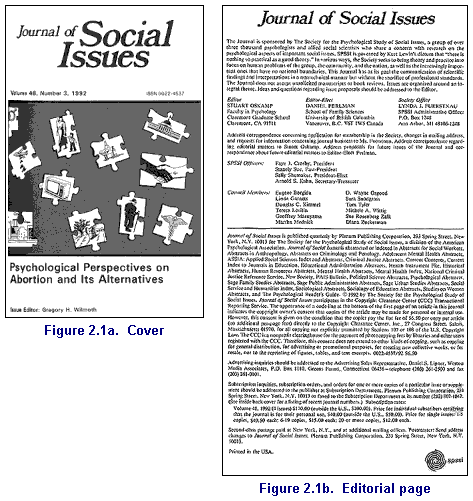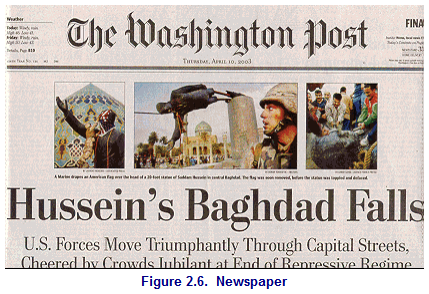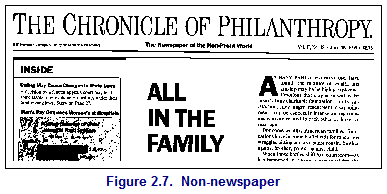Cataloger's Reference Shelf
CONSER Cataloging Manual
2.1. What is a serial?
2.1.1. Definition and characteristics
Consider a publication to be a serial if it meets the criteria set by the definition in AACR2:
|
A continuing resource issued in a succession of discrete parts, usually bearing numbering, that has no predetermined conclusion. |
THE RESOURCE IS ISSUED IN A SUCCESSION OF DISCRETE PARTS
A "part" is most frequently referred to as an "issue" by serials catalogers (e.g., the March 1989 issue of Atlantic). A serial consists of separate issues, each of which stands alone (e.g., an annual directory) or comprises part of a volume that will later be collected together (e.g., a monthly issue of a periodical, the 12 parts of which will be bound in a single volume). Sometimes there are several levels, such as issues and parts (e.g., an annual statistical publication that is issued in two parts each year). Some issues are cumulated and supersede all of the preceding issues. With electronic journals, the need for the issue has diminished and the parts may consist of separately numbered articles. What is important is that the issues or parts remain intact or discrete. This is the primary distinction between serials and integrating resources and is an important determination in the way in which they are cataloged.
THE RESOURCE USUALLY BEARS NUMBERING
AACR2 uses the term numbering to refer to numbers, dates, or combinations of both that identify the individual issues or parts of a serial. The term is also referred to as the designation or the enumeration and chronology. Numbering is important for check-in and recording of holdings so that issues can be properly identified and retrieved. Serials are generally collated by their enumeration/chronology before being bound or microfilmed. There are serials that lack numbering. These include unnumbered series and publications where the first issue lacks a designation but it is assumed that the publisher will provide numbering on subsequent issues (see also 2.1.3c). In most other cases, an unnumbered resource is treated as a monograph. Choosing the appropriate numbering and deciding how it is to be recorded is discussed in Module 8.
THE RESOURCE HAS NO PREDETERMINED CONCLUSION
While both serials and multiparts are successively issued, the factor that distinguishes them is whether they are continuing or finite. Because the multipart has an intended conclusion, even if not for some time, it is a monograph. Having “no predetermined conclusion” means that there is no stated or obvious finiteness, such as a limited scope.
Having no predetermined conclusion does not mean that the serial will never end–only that the publisher originally had no intention of ending it. A serial that dies after one or two issues is still a serial. Determining the intent of the publisher is probably the most difficult aspect of the definition since it may not be stated anywhere in the publication. The intention must often be surmised. Different ways of deciphering the publisher's intent are discussed in section 2.3 of this module.
By exception, Chapter 12 also allows that certain types of finite resources to be cataloged using the rules for serials. These are covered in section 2.1.3 below.
2.1.2. Types of resources covered by the definition
The following discussion lists common types of serials. While certain categories of publications are cited in this module as being representative of the types of publications that are normally cataloged as serials, integrating resources, or monographs, terminology alone does not determine treatment. For instance "encyclopedias" are cited as a type of publication that does not usually meet the criteria for a serial, but a regularly issued publication, such as the Encyclopedia of Associations, is cataloged as a serial.
AACR2 does not define "periodicals;" however, catalogers generally follow the definition used under earlier rules:
A serial appearing or intended to appear indefinitely at regular or stated intervals, generally more frequently than annually, each issue of which normally contains separate articles, stories, or other writings ( FN1).
This definition best describes "magazines," perhaps the most commonly known type of periodical because they are published for the general public. While not all periodicals are true magazines, most of them at least look like magazines, having a similar format consisting of a cover followed by editorial or contents pages, and lacking a title page. (Figure 2.1.)
Another common type of periodical is the electronic journal. Publishing journals and magazines online has become very popular because of the timeliness of availability and the ease of accessing and printing individual articles. Many of these journals are packaged in “aggregations” (see Module 31).
Making the distinction between a periodical and any other type of serial is not critical to the cataloging since the same rules are applied to catalog all types of serials ( FN2). Perhaps the most important distinction between periodicals and other serials is not in the way they are cataloged but in the way they are housed. Many libraries house current issues of periodicals separately from the rest of the serial collection until the issues are bound or microfilmed. And while some libraries shelve bound periodicals by call number with other materials, other libraries shelve them alphabetically by title.

Figure 2.1. is a typical periodical. The cover is followed by an editorial page containing the masthead and details of publishing. Following this page is the contents page. There is no title page.
b. Annual reports and recurring reports of activities
|
|
Many agencies, businesses, and institutions issue a report on a regular basis, such as an annual or biennial report. Such reports usually have a title page and are most often identified by date (Fig. 2.2.). Annual, quarterly, etc. reports of limited term projects are now treated as serials, even though they have a predetermined conclusion. They are among the types of resources that are cataloged using the serial rules according to AACR 12.0A1, revised in 2002 (covered in section see 2.1.3a. below). |
c. Directories, yearbooks, and other similar reference works
|
Many reference works, such as directories and yearbooks, are cataloged as serials because they are issued regularly to be kept up-to-date. Such publications are often identified by a number or date accompanied by the word "edition." Examples are Research Centers Directory, Yearbook of International Organizations, and Ulrich’s International Periodicals Directory (Fig. 2.3.). Reference works issued in editions that are issued irregularly or infrequently are often cataloged as monographs (see CCM 2.1.4a). Note that because these are updating resources, when they are issued electronically, they are usually integrating resources. |
|
|
|
Newsletters are issued by corporate bodies or individuals to provide news on a topic and recent activities. Most newsletters lack a cover and title page. Instead, the title is usually found in a caption appearing at the top of the first page of text. An example is The NASIG newsletter (Fig. 2.4.). |
|
Publications containing statistics that are gathered and issued regularly are treated as serials. While many statistical publications are issued more than once a year, they are not generally coded as periodicals because they do not contain articles. This category includes many government publications. (Fig. 2.5.) |
|
A newspaper is defined by the International Organization for Standardization as:
A serial publication which contains news on current events of special or general interest. The individual parts are listed chronologically or numerically and appear usually at least once a week. Newspapers usually have a masthead rather than a cover and are normally larger than A3 (297 mm x 420 mm) in size.
Newspapers cover general news. Special interest newspapers, whose focus is general news of interest to a specific group (e.g., ethnic newspapers), are also cataloged as newspapers. Publications that are issued in newspaper format or on newsprint and that cover a specific topic (e.g., Women's wear daily) are not newspapers, nor are publications that call themselves newspapers but cover a specific topic (e.g., The Economist). The serials cataloger must be able to distinguish newspapers from other serials since there are distinctions made in the cataloging of newspapers ( FN3). See Module 33. Newspapers, for more details on newspaper cataloging.

The Washington Post is a newspaper because it covers general news. (Figure 2.6.)

The Chronicle of Philanthropy (Figure 2.7.) is not a newspaper, even though it calls itself "the newspaper of the non-profit world" because it covers a specific topic.
g. Legal and official publications
Publications such as court reports, administrative regulations, and gazettes are serials (e.g., Federal register). Legal serials are covered separately in Module 34.
While both numbered and unnumbered series fit the definition of serial, in many cases the individual issues in a series are cataloged as separate monographs. Series are included in section 2.2. Special types of resources.
2.1.3. Other resources treated as serials according to 12.0A
While most resources must meet the definition in all aspects in order to be cataloged as serials, there are occasions when a resource can be cataloged using the rules for serials even though one aspect of the definition is wanting. The first two categories below are covered by AACR2 12.0A1, the third is a further clarification of when unnumbered resources can be treated serially.
a. Publications of limited duration
Rule 12.0A1 says that “resources that exhibit characteristics of serials, such as successive issues, numbering, and frequency, but whose duration is limited” are treated as serials and cataloged according to the serial rules in Chapter 12. Examples of limited duration resources include annual or quarterly technical reports of limited-term projects, an annual report of a commission that is only to exist for five years, a newsletter from a single event such as the 1992 Winter Olympics, or the working papers of a single conference. Such resources function similarly to serials, covering events that occur over time, whereas multipart monographs generally cover a defined scope of material that cannot be contained in a single volume.
|
|
Examples are United Nations Transport and Communications Decade in Africa (1978-1988) : annual progress report (Fig. 2.8.) and Decade Link, a publication of the Ecumenical Decade of Churches in Solidarity with Women which is issued 2-3 times a year, presumably for ten years. |
Reprints of serials are also treated as serials according to AACR2 12.0A1, even when they are published as a finite set of volumes. Since they substitute for the original serial, it is desirous that the cataloging be similar and that they file with the original. Details on the cataloging of reprints are included in Module 17.
c. Resources that lack numbering
As noted above, numbering is important to the identification and control of serials. In most cases, therefore, a resource that bears no more than a publication or copyright date is treated as a monograph, rather than as a serial.
However, when there are clear indications that the publication is a serial but the publisher has failed to provide a numbering on the first issue, AACR/LCRI 12.3D1 allows the cataloger to 1.) supply a designation following the form of numbering on subsequent issues when that is known; 2.) When the publication date is not present, and a chronological designation is appropriate to identify the issue, a copyright date can be used to supply the chronological designation; 3.) When a chronological date is not appropriate, [No. 1]- is given.
Note: When there is no copyright date or publication date, a best estimate is supplied (as either a chronological designation or [No.1-] whichever is appropriate) based on information within the publication itself, from the publisher (if this can be obtained) or other external sources.
|
|
In this example, the first issue was published with only the copyright date of 1989 (which appears on the verso of the title page). When it was first cataloged, the designation would have been 362 0 [1989]- . The record now reflects the designation system adopted on later issues.
245 04 $a The annual directory of American bed & breakfasts. 260 ## $a Nashville, Tenn. : $b Rutledge Hill Press, $c c1989- 362 0# $a [1990 ed.]-
See Module 8, Section 5.1 for other examples. |
2.1.4. Successively-issued resources that exhibit seriality but are usually treated as monographs
a. Publications revised on an irregular or infrequent basis
A publication that comes out in revised editions only as the need arises is not a serial because there is no clear intention for it to continue. Most textbooks and dictionaries fall into this category, as do handbooks and manuals that are not regularly revised.
|
Because this dictionary is revised on an irregular basis, it is cataloged as a monograph. (Figure 2.10.)
|
|
LC makes some exceptions to this policy by treating certain irregularly revised resources as serials. These include travel guides, alumni directories, and sales catalogs.
Also called multiparts, multipart items are works that are finite in scope and usually have some predetermined conclusion, even though it may be over many years. Encyclopedias are the most common example. The Handbook of the Birds of India and Pakistan is an example of a multipart item. Each volume contains a portion of the total number of birds covered in the work, for example, vol. 2 covers "Megapodes to Crab Plover," vol. 3, "Stone curlews to Owls," and so forth.
|
|
Resources that consist of a monograph and separately issued supplements are treated as monographs, even when the supplements are issued on a frequent or regular basis. If, however, a publication begins as a monograph and is subsequently issued serially, the publication is cataloged as a serial (e.g., 1st issue covers 1937-1956, annual volumes issued each year thereafter). In Fig. 2.11., Food Chemicals Codex is a monograph and thus, this supplement is noted on the record for the monograph. |
See also: